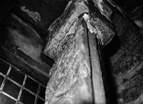Select a site alphabetically from the choices shown in the box below. Alternatively, browse sculptural examples using the Forward/Back buttons.
Chapters for this volume, along with copies of original in-text images, are available here.
Object type: Part of mid-wall shaft
Measurements: H. 50 cm (20 in); W. (max.) 22.5 cm (9 in), (chamfered faces) 12.5 cm (5 in); D. (max.) 17.5 cm (7 in)
Stone type: Medium-grained yellow sandstone (Carboniferous sandstone?)
Plate numbers in printed volume: 644–7
Corpus volume reference: Vol 2 p. 167-168
(There may be more views or larger images available for this item. Click on the thumbnail image to view.)
It is difficult to see all round this polygonal shaft but part of its east face appears to be flattened and chamfered. The southern and western faces are divided by heavy roll mouldings into plain and grooved panels, and the shaft appears to chamfer slightly towards the 'back' (east as set). It has been cut down at the top and bottom.
Appendix A item (stones dating from Saxo-Norman overlap period or of uncertain date).
Although the Taylors noted that this shaft was decorated, their Description that it was 'ornamented along the upper half of its surface with incised fluting' (Taylor and Taylor 1965, i, 448) seems to imply that the shaft was all one, when it consists of two distinct fragments. Moreover, the ornament is not strictly 'fluting'. A shaft with precisely similar ornament has been discovered in excavations at The Hirsel, Coldstream, Berwickshire, unfortunately not in situ but associated with a church of possibly pre-Conquest foundation (Cramp and Douglas-Home 1977–8, pl. 17 and fig. 2). The Hirsel shafts have five panels divided by heavy roll mouldings and taper opposite the rounded face. It is possible that the Morland shaft originally was that shape but has been cut back for reuse. Its position in the late Saxon tower is not primary and it could have been set there at any time after the church was constructed. On the other hand, the plain rectangular fragment which supports it from below could also be a replacement. If the original shape of this shaft was like those from The Hirsel, then it was originally shaped to be engaged into a wall.
Taylor and Taylor 1965, II, 448
==R.J.C.



